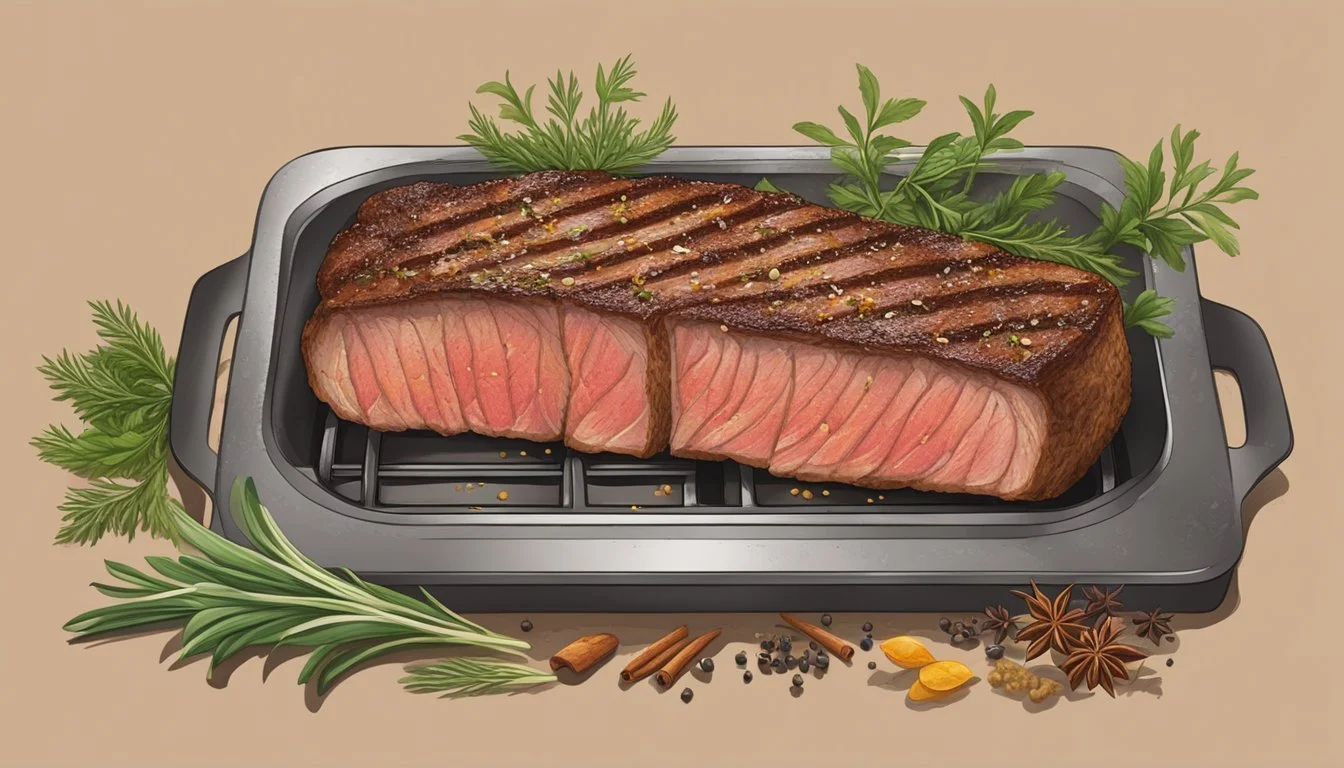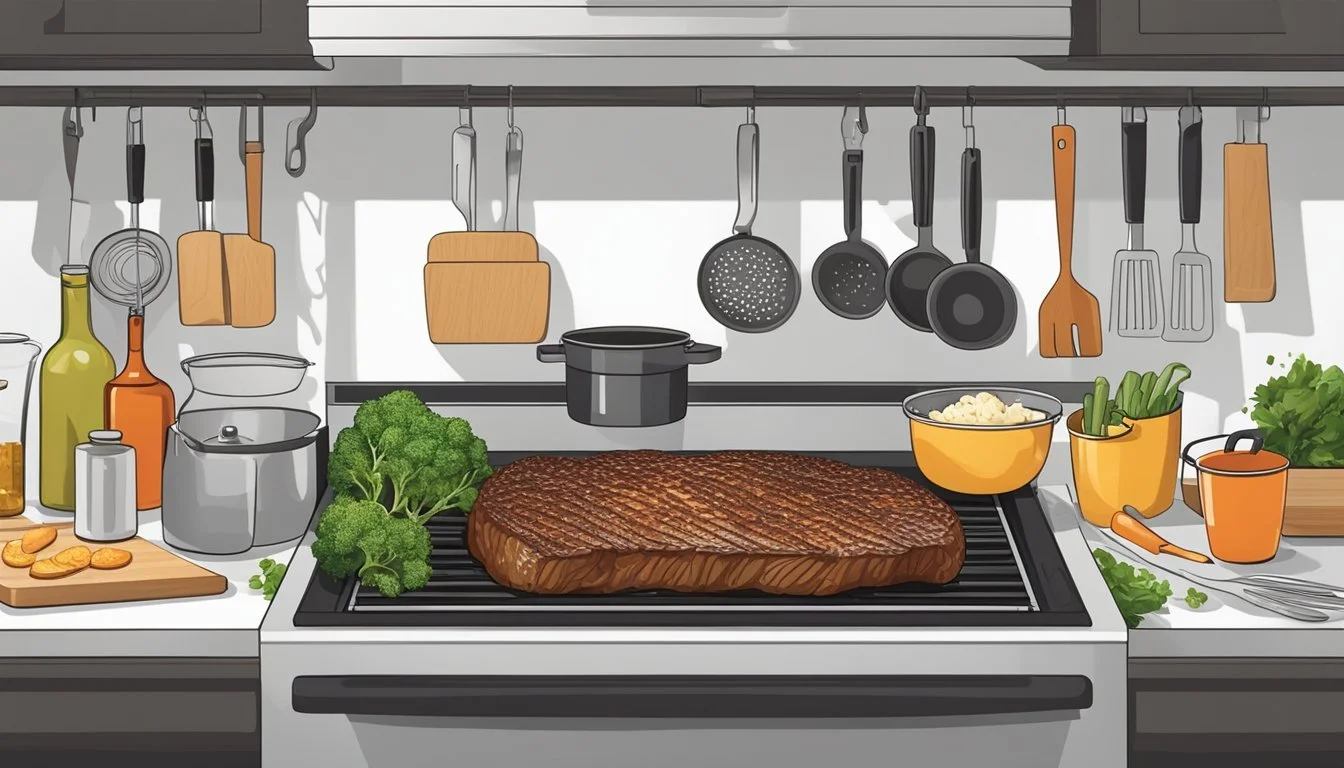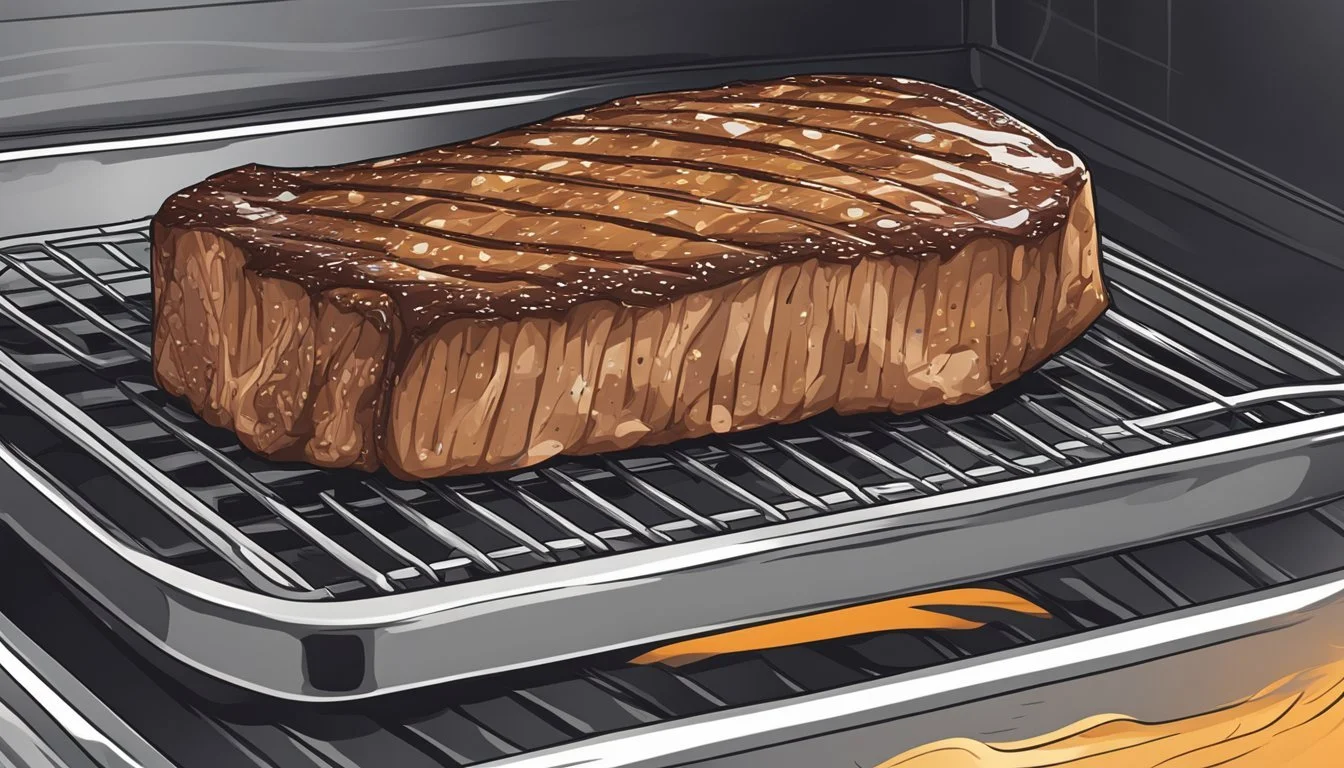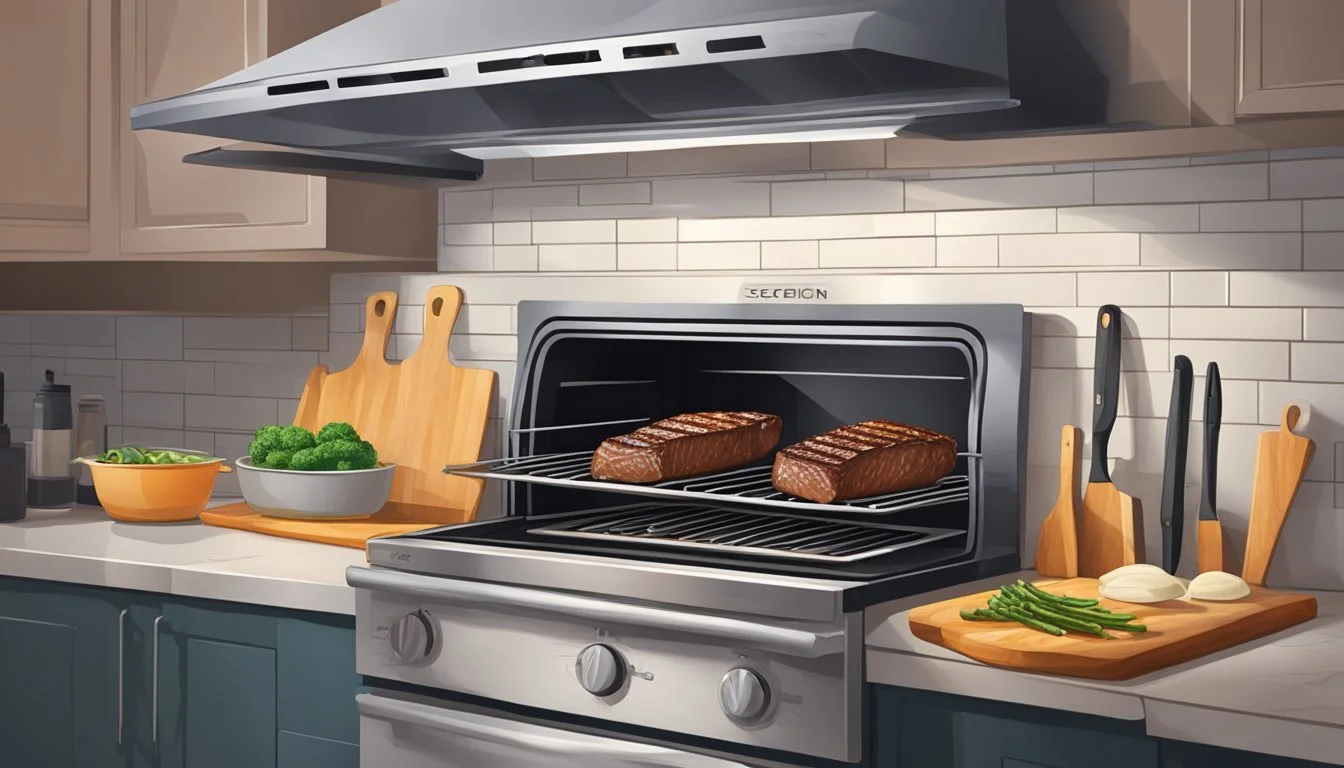Perfect Oven-Roasted New York Strip
Juicy and Tender Every Time
New York strip steak is a classic cut of beef prized for its rich flavor and tender texture. While many prefer grilling this cut, cooking it in the oven offers a foolproof method to achieve steakhouse-quality results at home. The key to perfectly cooking a New York strip in the oven is to start by searing it in a hot skillet, then finish it off in a preheated 400°F oven until it reaches the desired internal temperature.
Preparing the steak properly before cooking is crucial. Allow it to come to room temperature for about 45 minutes, then pat it dry and season generously with salt and pepper. This ensures even cooking and a flavorful crust. A cast-iron skillet is ideal for searing the steak, as it retains heat well and can go straight from stovetop to oven.
The cooking time will vary depending on the thickness of the steak and desired doneness. For a medium-rare result, aim for an internal temperature of 130-135°F, which typically takes 5-7 minutes in the oven after searing. Remember to let the steak rest for a few minutes before slicing to allow the juices to redistribute throughout the meat.
Choosing the Right Cut
Selecting the perfect New York strip steak is crucial for achieving a delicious result when cooking in the oven. The right cut impacts flavor, tenderness, and overall cooking performance.
Identifying Quality New York Strip Steak
Look for steaks with a bright red color and visible marbling throughout the meat. Marbling refers to the white fat streaks within the muscle, which contribute to flavor and juiciness.
Choose steaks with even distribution of fat for consistent cooking. Avoid cuts with large chunks of external fat, as these can cause flare-ups in the oven.
NY strip steaks are typically leaner than ribeyes but should still have some intramuscular fat. This balance makes them a popular choice for those seeking a flavorful yet relatively lean cut of beef.
Understanding Steak Thickness and Cooking Impact
The thickness of the steak significantly affects cooking time and final texture. Aim for steaks that are 1 to 1.5 inches thick for optimal results in the oven.
Thicker steaks (1.5 inches) allow for a nice crust while maintaining a juicy interior. They're ideal for achieving medium-rare to medium doneness.
Thinner steaks (under 1 inch) cook faster but risk overcooking. They're better suited for quick high-heat methods rather than oven roasting.
Consider the number of servings needed. A 1-inch thick, 8-ounce NY strip typically serves one person generously.
Preparation and Ingredients
Proper preparation is key to achieving a perfectly cooked New York strip steak in the oven. The right seasoning, marinating, and temperature control set the foundation for a delicious result.
Seasoning the Steak
Salt and pepper form the base of any good steak seasoning. Use kosher salt for its coarse texture and ability to adhere to the meat. Freshly ground black pepper adds a sharp, spicy kick.
For added flavor, incorporate garlic powder, paprika, and onion powder. Mix these ingredients in a small bowl to create a custom steak rub.
Apply the seasoning generously to both sides of the steak, pressing it into the meat. This ensures the flavors penetrate beyond the surface.
Fresh herbs like rosemary and thyme can elevate the taste profile. Chop them finely and sprinkle over the steak just before cooking.
Marinating for Flavor
Marinating can infuse the steak with additional flavors and help tenderize the meat. Create a simple marinade using olive oil, minced garlic, and chopped fresh herbs.
Place the steak in a shallow dish or resealable plastic bag. Pour the marinade over the meat, ensuring it's evenly coated.
Refrigerate for 30 minutes to 2 hours. Avoid marinating for too long, as the acid in the marinade can start to break down the meat fibers.
Pat the steak dry with paper towels before cooking to remove excess moisture. This promotes better browning in the oven.
Bringing the Meat to Room Temperature
Remove the steak from the refrigerator 30-60 minutes before cooking. This allows the meat to come to room temperature, promoting even cooking throughout.
Place the steak on a clean plate or cutting board. Cover loosely with plastic wrap to prevent contamination.
As the steak warms up, its fibers relax, resulting in a more tender final product. Room temperature meat also cooks more evenly, reducing the risk of an overdone exterior and undercooked interior.
Use this time to preheat your oven and prepare any side dishes. A well-heated oven ensures consistent cooking temperatures for the perfect steak.
Starting with a Sear
Searing creates a flavorful crust on your New York strip steak before finishing it in the oven. This technique locks in juices and enhances the overall taste.
Searing Techniques
Preheat a skillet over high heat until it's smoking hot. Pat the steak dry with paper towels to remove excess moisture. Season generously with salt and pepper. Add a small amount of oil with a high smoke point to the pan. Place the steak in the skillet and let it cook undisturbed for 2-3 minutes. Resist the urge to move it around.
Flip the steak once a deep brown crust has formed. Sear the other side for an additional 2-3 minutes. Use tongs to briefly sear the edges, holding the steak upright for about 30 seconds per side.
Using the Right Skillet
A cast iron skillet is ideal for searing steaks. It retains heat well and creates an even cooking surface. Ensure your skillet is oven-safe, as you'll transfer it directly to the oven after searing.
Preheat the cast iron pan for several minutes before adding the steak. This ensures it's hot enough to create a proper sear. A 10-12 inch skillet works well for most strip steaks. Avoid overcrowding the pan, which can lead to steaming instead of searing.
If you don't have cast iron, a heavy-bottomed stainless steel pan can also work. Avoid non-stick pans, as they typically can't withstand the high heat needed for a good sear.
Oven Cooking Methodology
Mastering the oven cooking method for New York strip steak ensures a perfectly cooked, juicy result. Proper temperature control and timing are key to achieving your desired doneness.
Preheating and Temperature Settings
Set your oven to 400°F (204°C) and allow it to fully preheat. This high temperature creates a nice crust on the exterior of the steak while keeping the inside tender.
Place a cast-iron skillet in the oven during preheating. The hot skillet will give the steak an excellent sear when you begin cooking.
For thicker steaks, you may opt for a lower temperature around 350°F (177°C) to allow for more even cooking throughout.
Cooking Time and Temperatures for Doneness
Cooking times vary based on steak thickness and desired doneness. Use this guide:
Rare: 125°F (52°C), 4-5 minutes
Medium-rare: 135°F (57°C), 5-7 minutes
Medium: 145°F (63°C), 7-9 minutes
Medium-well: 150°F (66°C), 9-11 minutes
Well-done: 160°F (71°C), 11-13 minutes
Always use a meat thermometer to check the internal temperature for accuracy.
Transfer to Oven and Cooking Techniques
After searing the steak on both sides in the hot skillet for 2-3 minutes each, transfer it to the preheated oven. Place the skillet on the middle rack for even heat distribution.
Avoid opening the oven door frequently to maintain a consistent cooking temperature. This helps achieve even cooking throughout the steak.
For extra flavor, add butter, garlic, and herbs to the skillet before putting it in the oven. Baste the steak with these aromatics halfway through cooking.
Let the steak rest for 5-10 minutes after removing it from the oven. This allows the juices to redistribute, resulting in a more tender and flavorful steak.
Additional Cooking Tools and Accessories
To achieve the best results when cooking New York strip steak in the oven, certain tools and accessories can make a significant difference. These items help ensure precise cooking and enhance the overall steak preparation process.
Using a Meat Thermometer
A meat thermometer is essential for achieving the perfect level of doneness in your New York strip steak. Insert the thermometer into the thickest part of the steak to get an accurate reading. For medium-rare, aim for an internal temperature of 130-135°F (54-57°C).
Digital instant-read thermometers provide quick and accurate results. Some models even offer preset temperatures for different levels of doneness, making it easier to achieve your desired outcome.
For continuous monitoring, consider using a leave-in probe thermometer. These devices allow you to track the steak's temperature throughout the cooking process without opening the oven door.
Choosing Oven-Appropriate Cookware
Selecting the right cookware is crucial for cooking New York strip steak in the oven. A cast-iron skillet is an excellent choice due to its heat retention properties. It can be preheated in the oven or on the stovetop for an initial sear before finishing the steak in the oven.
Alternatively, a heavy-duty baking sheet paired with a wire rack can be used. The rack elevates the steak, allowing hot air to circulate and promoting even cooking. This setup also helps prevent the steak from sitting in its own juices, which can inhibit browning.
For easy cleanup, line the baking sheet with aluminum foil before placing the wire rack on top. This catches any drippings and makes post-cooking cleanup a breeze.
Resting and Serving
Proper resting and serving techniques are crucial for achieving a perfectly cooked New York strip steak. These final steps ensure optimal flavor, texture, and presentation.
The Importance of Resting
After removing the steak from the oven, allow it to rest for 5-10 minutes. This resting period is essential for redistributing the juices throughout the meat.
During cooking, heat pushes the juices towards the center of the steak. Resting allows these juices to spread back out, resulting in a more evenly moist and flavorful steak.
Place the steak on a cutting board or warm plate. Loosely tent it with aluminum foil to retain heat while resting.
Avoid cutting into the steak immediately after cooking, as this will cause the juices to spill out, leaving you with a drier piece of meat.
Carving Techniques
To maximize tenderness, carve the New York strip steak against the grain. This means cutting perpendicular to the direction of the muscle fibers.
Use a sharp knife to make clean cuts. Aim for slices about 1/4 to 1/2 inch thick.
Hold the steak steady with a fork while slicing. Make smooth, even strokes with the knife to avoid tearing the meat.
For optimal presentation, arrange the slices on a warm plate, slightly overlapping each other.
Serving Suggestions
Serve the New York strip steak immediately after carving to ensure it's still warm and at its peak flavor.
Pair the steak with classic sides like roasted potatoes, grilled asparagus, or a fresh green salad.
Consider offering a variety of sauces on the side, such as béarnaise, peppercorn, or chimichurri.
Garnish the plate with fresh herbs like rosemary or thyme for added aroma and visual appeal.
For a complete steakhouse experience, serve with a bold red wine like Cabernet Sauvignon or Malbec.
Remember to provide sharp steak knives to your guests for easy cutting and enjoyment of the tender, juicy steak.
Pairings and Accompaniments
A perfectly cooked New York strip steak deserves thoughtful accompaniments to create a well-rounded meal. The right side dishes and beverages can enhance the flavors of the steak and provide a balanced dining experience.
Complementary Side Dishes
A crisp, fresh salad offers a light contrast to the rich steak. Consider a simple mixed green salad with a tangy vinaigrette or a classic Caesar salad with crunchy croutons.
Roasted or grilled vegetables provide color and nutritional balance. Asparagus, Brussels sprouts, or bell peppers are excellent choices.
Sautéed mushrooms complement the meaty flavors of the steak. Try cremini or shiitake mushrooms cooked with garlic and herbs.
For a hearty option, serve a baked potato topped with sour cream, chives, and bacon bits. Alternatively, creamy mashed potatoes or crispy roasted potatoes work well.
Grilled corn on the cob or creamed spinach are classic steakhouse sides that pair nicely with NY strip.
Wine and Beverage Pairings
Full-bodied red wines are traditional pairings for NY strip steak. Cabernet Sauvignon, Malbec, or Syrah/Shiraz stand up well to the bold flavors of the meat.
For white wine lovers, a full-bodied Chardonnay can be a surprising match.
Beer enthusiasts might enjoy a dark stout or a hoppy IPA with their steak.
Non-alcoholic options include sparkling water with lemon, unsweetened iced tea, or a mocktail like a virgin Bloody Mary.
For a special touch, consider serving a bold espresso or cappuccino after the meal to aid digestion and cleanse the palate.
Cleanup and Maintenance
Proper cleanup and maintenance are crucial for ensuring the longevity of your cookware and maintaining a clean kitchen after preparing a delicious New York strip steak.
Cleaning Your Skillet
After cooking, allow the skillet to cool slightly. Use hot water and a stiff brush to scrub away food particles. Avoid using soap, as it can strip the seasoning. For stubborn bits, add coarse salt as a gentle abrasive. Rinse thoroughly and dry immediately with a clean cloth.
Heat the skillet on low for a few minutes to evaporate any remaining moisture. Apply a thin layer of oil to maintain the seasoning. Wipe away excess oil with a paper towel.
Proper Storage of Cast Iron
Store cast iron skillets in a dry place to prevent rust. If stacking, place a paper towel between pans to absorb moisture and prevent scratching. Consider hanging heavy skillets to save cabinet space and showcase your cookware.
For long-term storage, apply a thin coat of oil to protect against rust. Wrap the skillet in paper or cloth to absorb excess moisture.
The Ventilation Factor
Proper ventilation is essential when cooking steaks at high temperatures. Use your range hood or open windows to remove smoke and odors. For gas stoves, ensure the flame doesn't extend beyond the pan's base to reduce smoke.
Consider using a splatter screen to minimize grease splatters. Clean range hoods and filters regularly to maintain efficiency. If smoke becomes excessive, lower the heat or finish cooking in the oven.
Good ventilation not only keeps your kitchen clean but also prevents smoke alarms from activating during high-heat cooking.
Reheating and Leftovers
Properly reheating a New York strip steak preserves its juicy texture and rich flavor. Careful storage and reheating techniques ensure leftover steak remains a delicious meal.
Best Practices for Reheating
Reheating steak in the oven yields excellent results. Preheat the oven to 250°F (121°C). Place the steak on a wire rack over a baking sheet to allow even heat circulation. Heat for 20-30 minutes or until the internal temperature reaches 110°F (43°C).
For stovetop reheating, use a skillet over medium-low heat. Add a small amount of oil or butter. Cook the steak for 3-4 minutes per side, flipping once.
Avoid microwaving, as it can lead to uneven heating and tough meat. If necessary, use 30-second intervals at medium power, flipping between each interval.
Always let the reheated steak rest for 5 minutes before serving to redistribute juices.
Maintaining Quality for Leftovers
Store leftover New York strip steak in an airtight container in the refrigerator within 2 hours of cooking. Properly stored, it will maintain quality for 3-4 days.
Before reheating, let the steak come to room temperature for 30 minutes. This promotes even heating and helps retain moisture.
To prevent dryness, consider adding a small pat of butter or drizzle of olive oil before reheating. This helps maintain the steak's juicy texture.
For longer storage, freeze the steak. Wrap it tightly in plastic wrap, then aluminum foil. Label with the date and use within 2-3 months for best quality.
Frequently Asked Questions
What's the ideal temperature for a medium-rare New York strip steak?
For medium-rare, aim for an internal temperature of 130-135°F (54-57°C). Use a meat thermometer to check doneness accurately.
Can I cook a New York strip steak from frozen?
It's best to thaw the steak first for even cooking. If cooking from frozen, increase the oven time by about 50% and use a meat thermometer to ensure proper doneness.
How long should I let the steak rest after cooking?
Let the steak rest for 5-10 minutes after cooking. This allows the juices to redistribute, resulting in a more tender and flavorful steak.
Is it necessary to sear the steak before putting it in the oven?
Searing creates a flavorful crust and helps seal in juices. While not strictly necessary, it's highly recommended for optimal taste and texture.
What's the best way to season a New York strip steak?
Salt and black pepper are classic choices. Apply seasoning generously before cooking. For added flavor, consider garlic powder, rosemary, or thyme.
Can I use a regular baking pan instead of a cast-iron skillet?
A cast-iron skillet is ideal for its heat retention, but a regular oven-safe pan will work. Ensure it's preheated for the best sear.
How do I achieve different levels of doneness?
Adjust cooking times and target temperatures:
Rare: 120-125°F (49-52°C)
Medium: 140-145°F (60-63°C)
Medium-well: 150-155°F (66-68°C)
Well-done: 160°F (71°C) and above






